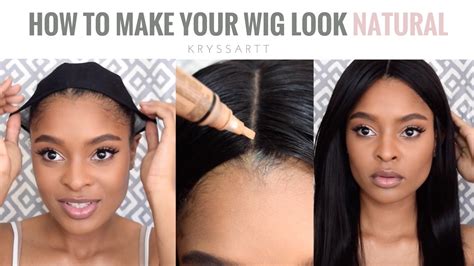Becoming More Yourself
Wigs have come a long way in recent years.Gone are the days of stiff, unnatural-looking wigs. Today’s wigs are made from high-quality materials that mimic the look and feel of real hair. They are also available in a wide range of styles, colors, and textures, so you can find the perfect one to match your own unique style.

If you have ever considered getting a wig, now is the time to do it. With so many great options to choose from, you are sure to find the perfect one for your needs.
Natural-Looking Wigs: 4 Types to Consider
-
Synthetic wigs: Synthetic wigs are made from man-made materials, such as polyester or nylon. They are typically less expensive than human hair wigs, and they come in a wide range of styles and colors. Synthetic wigs are also heat-resistant, so you can style them with heat tools.
-
Human hair wigs: Human hair wigs are made from real human hair. They are more expensive than synthetic wigs, but they offer a more natural look and feel. Human hair wigs can be styled with heat tools, and they can be dyed or bleached.
-
Lace front wigs: Lace front wigs are made with a thin lace that is applied to the front of the wig. This creates a natural-looking hairline that is virtually undetectable. Lace front wigs are more expensive than traditional wigs, but they offer a more realistic look.
-
360 lace wigs: 360 lace wigs are similar to lace front wigs, but they have lace all around the perimeter of the wig. This creates a natural-looking hairline that can be styled in any direction. 360 lace wigs are the most expensive type of wig, but they offer the most natural look.
Natural-Looking Wigs: Benefits That Matter
- Enhance your confidence. A wig can give you the confidence boost you need to feel your best. If you have been struggling with hair loss or thinning hair, a wig can help you regain your sense of self-esteem.
- Change your style instantly. With a wig, you can change your style in an instant. You can go from long to short, curly to straight, or even blonde to brunette.
- Protect your hair from damage. If you are prone to hair damage, such as split ends or breakage, a wig can protect your hair from further damage. You can wear a wig to protect your hair from the sun, wind, and other environmental factors.
- Experiment with different looks. A wig is a great way to experiment with different looks without having to make a permanent change to your hair. You can try out new hairstyles, colors, and textures without any commitment.
Natural-Looking Wigs: Effective Strategies for Choosing the Right One
- Consider your face shape. The shape of your face will determine the best wig style for you. If you have an oval face, you can wear any type of wig style. If you have a round face, you should avoid wigs with blunt bangs or layers. If you have a square face, you should avoid wigs with sharp angles or layers.
- Choose the right color. The color of your wig should match your skin tone and hair color. If you have fair skin, you should choose a wig with a light or medium brown color. If you have medium skin, you should choose a wig with a medium or dark brown color. If you have dark skin, you should choose a wig with a black or dark brown color.
- Select the right texture. The texture of your wig should match the texture of your own hair. If you have straight hair, you should choose a wig with straight hair. If you have curly hair, you should choose a wig with curly hair. If you have wavy hair, you should choose a wig with wavy hair.
- Get a professional consultation. If you are not sure which wig style is right for you, you can get a professional consultation from a wig specialist. A wig specialist can help you choose the right wig style, color, and texture for your individual needs.
Natural-Looking Wigs: FAQs for Your Queries
-
How do I care for a wig?
To care for a wig, you will need to wash it, condition it, and style it regularly. You should wash your wig every 1-2 weeks, or more often if you wear it frequently. You should condition your wig every 2-3 weeks, or more often if it is dry or damaged. You should style your wig as desired, using heat tools if necessary.
-
Can I swim in a wig?
Yes, you can swim in a wig, but it is not recommended. Chlorine and salt water can damage the wig fibers, causing them to become dry, brittle, and tangled. If you do swim in a wig, be sure to rinse it out with fresh water immediately afterwards and condition it to prevent damage.
-
Can I sleep in a wig?
Yes, you can sleep in a wig, but it is not recommended. Sleeping in a wig can cause the wig to become matted and tangled. It can also put stress on the wig fibers, causing them to break. If you do sleep in a wig, be sure to braid or wrap it up in a scarf to protect it from damage.
-
How long will a wig last?
The lifespan of a wig will vary depending on the type of wig, how often it is worn, and how well it is cared for. Synthetic wigs typically last for 6-12 months, while human hair wigs can last for 1-3 years.
-
How much does a wig cost?
The cost of a wig will vary depending on the type of wig, the quality of the materials, and the brand. Synthetic wigs typically cost between $50-$200, while human hair wigs can cost between $200-$2,000.
-
Where can I buy a wig?
You can buy a wig online, at a wig store, or at a beauty supply store. When buying a wig, be sure to shop around and compare prices to get the best deal.
-
Can I return a wig if I don’t like it?
Most wig stores offer a return policy, but it is important to check the store’s policy before purchasing a wig. Some stores may charge a restocking fee for returned wigs.
-
How do I find a wig specialist?
You can find a wig specialist by searching online or asking for recommendations from friends or family members. Wig specialists can help you choose the right wig style, color, and texture for your individual needs.
